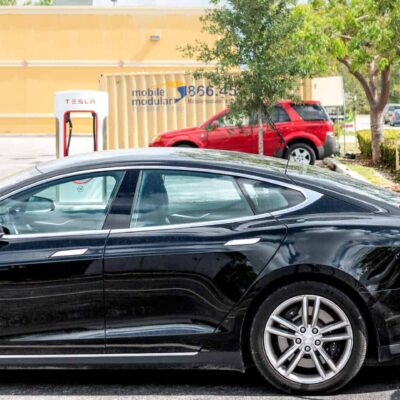When it comes to the creation of any moving technology, manufacturers’ major concerns surround developing a reliable, portable power source that has enough energy to mobilize their machines. We’ve seen cars powered by steam, fossil fuels, and even corn on our quest for the ultimate sustainable energy source. But today, car manufacturers are facing a new era of power production issues as we enter the age of the electric car. With transportation accounting for 29% of the United States’ greenhouse gas emissions and the government’s push to have half of all new automobiles be zero-emission by 2030, the shift towards a ‘material-intensive energy system‘ is rapidly advancing.
This increased interest in electric vehicles has made the EV battery market a $27 billion industry. This is projected to grow to $127 billion as more affordable EVs become available. But as exciting as this evolution may seem, there are still some wrinkles in battery production that need ironing out before we can truly reach the zero-emission future our world governments are vying over. As our experts discussed in Chapter 1 of our EV Panel, expansion in electric vehicle battery manufacturing can positively impact the growth of the market. But our experts also highlighted heightened costs, production emissions, material scarcity, and trade theft as roadblocks in our journey to 2030. Let’s examine these issues further.
Increased Costs
We all know that electric vehicles tend to come with a higher price tag than your typical fuel-filled car, and that can be attributed to higher manufacturing costs. Since government policies and investors alike are pushing automakers towards a fully electric fleet, many manufacturers can’t sustain the increased expenses. In an interview with Reuters, Stellantis CEO Carlos Tavares illustrated this concern when he explained that rapid electrification creates 50% additional costs against a conventional vehicle. This, in turn, makes it impossible for companies to transfer 50% of the additional costs to the consumer since it will inflate the price tag beyond their budgets.
Even though electric vehicle costs are expected to fall as we move further into the second half of this decade, the present push towards electrification not only increases production costs but also threatens vehicle quality. We have seen this happen firsthand with the Chevy Bolt. As GM raced to gain stakes in the EV market, it released the Bolt with batteries manufactured by Asia’s LG Energy Solution. The batteries had a torn anode tab and folder separator in the same cell; this increased fire risk and pushed GM to make a $1.8 billion recall on 2019-2022 model-year vehicles.
The class-action suits opened against GM over the Chevy Bolt fires should be used as a cautionary tale for other manufacturers. This isn’t the first time automakers have been prosecuted for faulty EV parts, and it likely won’t be the last. Our automotive expert Larry Achram feels that the biggest issue facing EVs now are these “thermal events.” According to Achram, thermal events will likely continue to occur with pressure to speed up charging time—which risks electric vehicle battery health safety—to remain competitive. We expect to see certain litigation in this space as companies continue to move forward fast with production.
To reduce costs, ease the stress on the supply chain, and mitigate legal issues, companies like GM are now trying to bring manufacturing and mining processes to American soil.
Mining for Materials
One aspect of battery manufacturing that our panel of experts all predict to cause issues is lithium mining. Lithium is used in these batteries because it is lightweight and able to store greater amounts of energy. The need for this material has ignited a global race for production dominance comparable to that of the gold or oil rushes, which in turn creates legal issues with production sites and technology innovation.
Currently, the United States almost fully relies on overseas lithium production; Asia is leading the pack in battery cell supply, and the struggles brought on by shipping these expensive, important, and heavy products to the US are pushing American companies to take manufacturing matters into their own hands. While the production of these materials in America is garnering support from the government and automakers alike, many are against these plants because mining for lithium isn’t as green as it may seem. Furthermore, this material is not everlasting; since lithium-ion batteries are used in everything from our cell phones to our power tools, this power source both creates emissions and supply-chain complications.
Bringing lithium production to the United States is essential to domestic EV growth, but we need to rethink our extraction methods if we want to make electric cars truly as sustainable as the market claims. Traditional mining methods are, for lack of a better term, dirty. They contaminate air, water, and wildlife, and this is creating some legal trouble for mining hopefuls. The US is currently looking to build a lithium mine in Nevada’s high desert that will represent one of the largest lithium production sites in the nation’s history. As The New York Times explained, lithium will be extracted by mixing clay with up to 5,800 tons of sulfuric acid a day. In turn, this creates 354 million cubic yards of mining waste that are loaded with discharge from the sulfuric acid treatment and potentially contain radioactive uranium.
This upsets locals and activists alike, leading them to protest the plant’s creation. Environmentalists filed a federal suit against the plant in January of 2021, but they were ultimately tossed in September of that year. We predict, though, that this won’t be the last of litigation surrounding lithium production plants. As more plans surrounding US mining begin to come to light, it would be remiss to assume that all will go off without a hitch.
Lithium Shortage
With demands surging, lithium is now seeing a global supply shortage. Reuters reported, “Total global production, measured as lithium carbonate equivalent, was forecast in December at 485,000 tons in 2021, growing to 615,000 tons in 2022 and 821,000 tons in 2023, according to Australia’s Department of Industry.” This increased production is also increasing cost; prices for the material have skyrocketed and this is now impacting battery cell production. Simon Moores, CEO of Benchmark Mineral Intelligence, says that there is a ‘great EV raw material disconnect’. There is not enough capacity to meet demand, creating a structural shortage.
He explained that it takes five to seven years to build a lithium mine; automakers are announcing new electric vehicle battery plants when they should be focusing on new lithium mines as they go hand and hand. Because of this, he says that “any of the EV goals between 2026 and 2030—it’s a red alert. Most of these guys won’t even meet a fraction of their EV targets because of that.” Overall, though, he predicts that prices and supply will be fine as there is no geological shortage. The battle to scale mining operations, though, is where legal problems may arise.
If your company needs help preparing for these challenges, reach out to WIT for the best experts who can advise you on your strategy. Our electric vehicles expert team was created to address what we expect to be the key areas of litigation in the move to electric fleets, and their knowledge covers all aspects of manufacturing.




